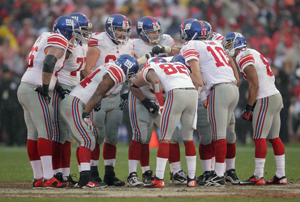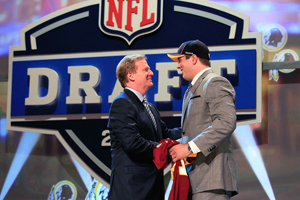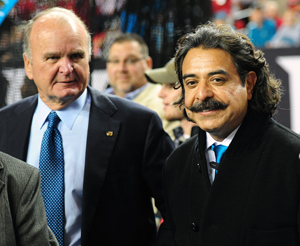For years leading up to last year’s labor standoff between the NFL and its players, the league insisted that without economic and structural changes, the sport might regress.
So how have the league, teams and players fared financially after the first season of the 10-year labor agreement?
Clearly in a cash-rich league, all have done fine, but the teams have especially and are well-positioned to improve their bottom lines as revenues balloon. The decline in team profit margins into the low single-digit percentages under the old collective-bargaining agreement, which the league complained crimped investments, is now reversing, experts and sources said.
Perhaps the best evidence of this is the San Francisco 49ers’ proceeding on a new $1 billion-plus stadium in Santa Clara, Calif., with banks signing up last month to lend $850 million to the project. Investments have also been flowing into teams, with the sale of the Jacksonville Jaguars for roughly $760 milllion, a $200 million equity sale of the Cincinnati Bengals, and a host of smaller limited partnerships in teams ranging from the 49ers to the Atlanta Falcons.
“I don’t know if owners would refer to the issues as being resolved, but there is more of a comfort level and less hesitancy,” said Andrew Brandt, a former Green Bay Packers executive, current president of the National Football Post, and a sports business professor at the Wharton School.
How they slice it
Under the old contract, players received as much as 54 percent of revenue, and by the last year of the deal with a salary cap, 51 percent. Under the new contract, players will most likely get less than 46 percent of the league’s revenue, though precise numbers are not available. The players were told before signing the CBA in August that they would get 47 percent of revenue, but those are revenues as defined in the CBA and do not include everything.
 |
Players could benefit as team owners, comfortable with higher profit margins, invest in ventures that could drive revenue far higher.
Photo by: Getty Images |
The CBA stipulates that players get 47 percent of what is defined as “All Revenues,” but there are a host of revenues not included in “All Revenues.” Descriptions of those revenues stretch over several pages in the CBA and include, for example, some permanent seat licenses, revenue from Dallas Cowboys merchandise wholesaling, and complimentary tickets. How much of the league’s projected $9.4 billion in revenue for 2011 is “non-All Revenues” is unclear.
In addition to those exceptions, the league can take expense deductions of at least 1.5 percent for stadiums, and credits for NFL Venture investments, meaning the net percentage players will receive is likely at least below an average of 46 percent. In other words, players will get 47 percent of revenues that have “non-All Revenues” shaved from the pie. And then the league can reduce the 47 percent figure for stadium and NFL Venture costs.
Under the last capped year of the previous labor deal, the players would have received $4.79 billion of the $9.4 billion of the revenue the league said it generated in 2011, as they were entitled to 51 percent of revenue. Conservatively presuming a 5 percent change to 46 percent, players would get around $4.32 billion under terms of the new, decade-long CBA, which would be a $470 million difference.
Some media reports in December, following the league’s announcement of new TV contracts that start in 2014, stated that the players had struck a windfall because they receive 55 percent of that money. In the end, however, no matter how much TV cash comes in, the players are capped at no more than 48.5 percent of “All Revenues” in any single year, and that is again before expense and revenue reductions.
Also, while it initially appeared as if the teams would need to spend a lot more cash than under the older deal, that’s not entirely the case. Under the old system, teams by the last year with a salary ceiling had to spend a minimum of 88 percent of that cap, Brandt said, though not all of that was cash. Teams could pay bonuses at the beginning of a contract, but amortize the value over the life of that deal. So if a player received a $10 million bonus over a five-year deal, the team could count $2 million toward the cap each year even if it was all paid in year one. Getting teams to spend more hard cash to meet cap obligations was a big agenda item for the players, and they got partly there.
In the first two years of the new deal, there is no minimum spending per club, while the league must average 99 percent of the cap, a number that was met in 2011 with the aid of bonus money, one team source said.
“Right now teams get a free ride this year and next year,” Brandt said.
From 2013 to 2016, teams must each average 89 percent cash spend to the cap, and the league overall 95 percent. For players, that is an improvement from the old deal because teams can no longer count amortized bonus money toward the cap. However, the percent requirement is an average of the four years and not required in any one season. A new four-year cycle with the same figures kicks in with 2017.
It was not all good news for the teams this season. While profit margins did improve, they did not rise as much as might be expected because of the large amounts of bonus money rookie contracts now consume, said one team source.
Because the new CBA significantly reduced rookie pay from the old deal, agents insisted on a far greater percentage of
 |
Restrictions on rookie pay are an effort to prevent huge sums going to unproven players.
Photo by: Getty Images |
the compensation being paid in signing bonuses, said this source. That means a lot of the compensation is front-loaded in year one. While that will keep the lid on margins somewhat this year, ultimately, this source said, the owners will see a significant return.
Owners also have to be happy with the significant restrictions on rookie pay. In addition to a major reduction on money paid to rookies, an effort by owners to prevent huge sums going to busts, the CBA disallows renegotiating contracts of rookies taken in the first two rounds until the end of the third year of their four-year contracts (teams have the option for a fifth year). And unlike the old CBA, teams can not put performance escalators into contracts for rookies drafted in the first two rounds. Performance bonuses are limited to how many plays that the players are on the field, thresholds defined in the CBA.
The flow of local dollars
Where the teams may be happiest — beyond the extra cash and easier-to-manage rookie system — is the reduced revenue disparity, an issue that had bitterly divided owners.
In the old system, the players shared every dollar equally. So if, for example, a new naming-rights deal went into the pool of money shared with players, each team, not just the beneficiary, saw its labor bill rise.
That does not change under the new system, but the effect is less severe. Now only 40 percent of local dollars are shared with the players. Say, for example, one team had $250 million of local revenue. Under the old system, by and large, 51 percent of that, or about $130 million, would have been shared with the players, causing about a $4 million bump per club in player costs.
Under the new system, $100 million of that is shared, or a $3.1 million bump per club. While supplemental revenue sharing is still necessary, the league expects that by the end of the deal, it will be required only in a handful of cases.
“By the time they get to the middle of the CBA term, the major issues they were dealing with should have been put to bed for the most part,” said Marc Ganis, a sports consultant with close ties to the NFL.
For the players, while they gave up some economically, they won significant concessions in player safety and a reduction in offseason commitments. And while rookies may not be happy with the new system, especially as it ties them to their clubs for as many as five years, some of that savings is flowing to veterans.
The NFL’s perspective is that the players do not lose economically because owners, comfortable with higher profit margins, will invest in businesses such as new stadiums and other ventures, like concession companies, that drive revenue far higher than would have occurred previously. So the contention is that players may be getting a smaller slice of the pie, but the pie will become much bigger.
“I don’t think players are unhappy right now, but when they see the way the business front offices are unleashed, they will” be very happy, said a team source.
The league’s biggest challenge for now is generating as much extra revenue as it predicted it could achieve if this type of CBA were approved.
While media money will surge in 2014 when the new TV deals arrive, with CBS, NBC and Fox paying $1 billion annually, the league must find new sources of cash. That could come from digital, technology, new stadiums, or perhaps categories that do not exist today.
 |
Within months of the NFL reaching an agreement on the new labor deal, Jacksonville Jaguars owner Wayne Weaver (left) had struck a deal to sell his team to Shahid Khan.
Photo by: Getty Images |
Commissioner Roger Goodell two years ago challenged owners to hit $25 billion annually in revenue by 2027, just six years after the end of the current CBA deal. Even adding the extra media money coming in from the networks and ESPN to 2011’s $9.4 billion total, that would get the league to only $12 billion annually.
One area players will not share in is the rise in franchise values, an issue the union pushed before the lockout.
The sale of the Jaguars likely set a floor on franchise values, said Rob Tilliss, founder of sports finance advisory firm Inner Circle Sports.
Jaguars ex-owner Wayne Weaver had for years tried to sell the team, though never getting the price he wanted. Then, within 3 1/2 months of the new CBA getting struck, he announced the sale of the team to Shahid Khan.
“Seven hundred and sixty million dollars is probably the new floor,” Tilliss said. “Getting more on the revenue and less costs is always helpful.”






